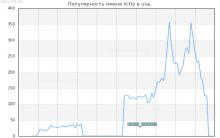Today, cemeteries are increasingly “growing” and occupy considerable areas in any country in the world. And if earlier relatives of the deceased came here to honor the memory of loved ones, then more and more often cemeteries are becoming a kind of cultural and historical place where tourists come and local residents come to relax, considering it their duty to visit the graves of famous writers, politicians, military leaders, and composers. What is the largest cemetery in Europe, which simply amazes with its enormous size?
1 Rostov-on-Don – Northern Cemetery
This is the largest cemetery in Europe, which is included in the famous Book of Records for its size. It is located in the northern part of the city and covers an area of more than 350 hectares. More than 355,000 dead are buried there. The Northern Cemetery opened in 1972. At the main entrance, visitors are “greeted” by the Poklonny Stone, which is a memorial composition with a towering cross. On the territory of the cemetery there is a temple (of the Intercession of the Blessed Virgin Mary), there is a columbarium and a crematorium. In addition to the fact that this place is recognized as the largest in Europe, it is also the largest in our entire country.
2 St. Petersburg – Northern Cemetery

Another one of the largest cemeteries in Europe can be called the resting place of the deceased in the northern part of St. Petersburg. The cemetery covers an area of 300 hectares, which is somewhat smaller in size than the cemetery in Rostov-on-Don.
3 Nizhny Novgorod – Novosormovo cemetery

This Nizhny Novgorod burial place can also rightfully be considered the largest cemetery in Europe, since 220 hectares of land have already been allocated for it. Whereas local authorities once stated that this area is incredibly large and “off scale” beyond the norm, which is only 40 hectares.
4 Odessa – Western Cemetery

Slightly smaller in size than the Nizhny Novgorod Cemetery, a burial site in the western part of Odessa. The area of this place is 200 hectares.
5 Vienna – Central Cemetery

The Vienna Cemetery, which has an area of 2.4 km2, is distinguished by its incredible size and unique beauty. More than 3,000,000 dead people are buried there. The cemetery, more like a beautiful park and a wonderful place for family recreation, was created in 1874. From its main entrance there is a wide alley, which allows you to visit the burial places of famous people of Austria (Beethoven, Schubert, Brahms) and improve your cultural level. Thousands of music fans of famous Austrian composers and musicians visit this place every year, eager to visit all the graves of deceased celebrities.
6 Paris – Père Lachaise

This place is considered a real museum of tombstones, because it is in Père Lachaise that Oscar Wilde, Edith Piaf, Jim Morrison, Honore de Balzac, Sarah Bernhardt and other French celebrities who once delighted society with their talents are buried. Russian Decembrists were also buried in this cemetery.
The area of this cemetery, opened by Napoleon in 1804, is approximately 48 hectares. In total, there are approximately 30,000 graves here. The largest cemetery in Paris and one of the largest in Europe, the cemetery is visited annually by millions of tourists who seek to honor the memory of great people and be amazed at the incredible beauty of this place.

They are a rather interesting burial place for the dead. The catacombs were made in the form of underground passages, which were created by a whole network and were used specifically for burial. In total, there are about sixty different catacombs in Rome, where 750,000 dead are buried. Moreover, even the remains of saints – the apostles Peter and Paul, executed in Rome – were once kept here. Tourists, of whom a huge number come here every year, are attracted to this place not only by the opportunity to see the remains of the greatest people, but also by the desire to contemplate the amazing paintings on the walls, the most beautiful frescoes and especially beautiful sarcophagi.
The variety of cemeteries in Europe can amaze the curious tourist: from ancient small graveyards to large-scale necropolises stretching over hundreds of hectares. The largest cemeteries in Europe are city-wide cemeteries, founded in the 19th and 20th centuries to bury the population of expanding cities. In our selection you will learn about the five largest cemeteries from five different countries:
Located near the city of Szczecin in western Poland, the Central Cemetery covers an area of 167 hectares and provides the final resting place for more than 300 thousand people. The cemetery was founded in 1901, when the city was still called Stettin and was part of Germany. The city government wanted to create a new, modern and convenient place for funerals, using the Ohlsdorf cemetery in Hamburg as a model.
After World War II, Szczecin became part of Poland, and the cemetery was renamed from the Main Cemetery of Stettin to simply the Central Cemetery. In addition, during the war, the central chapel, built in 1930 in the new part of the cemetery, was destroyed, and the communist leadership did not restore it. But the original temple survived, although in the 80s it almost died in a fire. After a long restoration, it was returned to its original appearance.

The main attraction of the Central Cemetery is the Brothers in Arms Monument, built in 1967, and looking like the two wings of the famous Polish hussars rising above the graves.
Brookwood Cemetery, also known as the London Necropolis, covers an area of 202 hectares where 235 thousand people are buried. This cemetery is a child of the industrial revolution. It was founded in 1845, when the capital of the British Empire - the largest city in the world at that time - was faced with the need to radically reform its funeral system. They even built a special railway line to Brookwood. In subsequent decades, the cemetery's management tried for many years to monopolize all funerals in the city, but never achieved their goal.

Brookwood grew even more in the second half of the 19th century, when London was actively rebuilt. The city authorities destroyed small church burials and removed the dead from there to a new place. In 1878, the UK's first crematorium was built in Brookwood, although this method of burial gained popularity only in the 20th century. In the cemetery you can find burials of representatives of many religions, including even separate areas allocated for Zoroastrians and Ismaili Muslims.
The very idea of creating such a huge cemetery arose in the mid-19th century, when Vienna was the center of a huge and mononational state. It would never have occurred to anyone then that the empire could collapse in less than a century, so a huge territory was allocated for a new cemetery. The official opening took place in 1874, and not without scandal: some Austrian conservatives opposed the multi-confessional nature of the new cemetery, designed to reflect the unity of the Empire.
However, after the opening, a new problem arose - the enormous distance from the cemetery to the city itself made funerals there too difficult, and most townspeople chose places closer. In order to somehow attract attention to their project, the authorities decided to make the cemetery “musical”. The remains of many composers who died in the capital of Austria were transported there: Beethoven, Schubert, Brahms, Salieri, Strauss and others. Mozart's cenotaph is also located there - the exact place of his burial remains unknown. As a result, over the years the cemetery gained popularity and even became part of city folklore. Traditionally, tram number 71 went to him, which is why “to ride the 71st tram” became a euphemism for death among the Viennese.

The largest cemetery-park in the world is located in the city of Hamburg. Its area is 391 hectares, on which about one and a half million people are buried. It is widely known as one of the attractions of Hamburg, where not only tourists, but also locals love to walk. It is very densely planted with trees and ornamental bushes, which is why many photographs give the impression that this is not a cemetery, but a public garden. At the cemetery there is a memorial to the fighters of the Hamburg Resistance - 55 anti-fascists executed by the Hitler regime during the years of dictatorship. Also at the Ohlsdorf cemetery, like at many other large German burial sites, there is a memorial to the victims of Nazism.
The history of the Oldorsf cemetery is quite prosaic: in 1877 it was established in rapidly growing Hamburg as a burial place open to representatives of all faiths and social groups. Over the following years, up to 40% of the dead in Hamburg were buried in the cemetery. And since the city’s population exceeded a million back in the 1920s, it is not surprising that by now the cemetery has acquired such impressive dimensions.

The Northern Cemetery holds the record for occupied area. A special bus runs through its territory of 400 hectares.
True, in terms of the number of burials, the Rostov burial site is still inferior to the largest European ones: as of 2019, about 500 thousand people were buried there. This is due, first of all, to the comparative youth of the Northern Cemetery, founded only in 1972. However, according to the administration, the number of funerals sometimes reaches 50 people a day, so in the coming decades the Rostov cemetery will grow rapidly.
Due to their youth, not many famous people are buried in the cemetery, although a number of Soviet soldiers and scientists found their final rest there. In the 90s, the Northern Cemetery became a popular final resting place for reputable businessmen who died during numerous property redistributions in the South of Russia.
You might be interested:
Graveyards for cars, trains, bikes and airplanes are often an eerie sight. And many of the largest vehicle cemeteries boast quite an interesting history.

Train cemetery in Bolivia

High in the Andes Mountains, in southwestern Bolivia, lies the Salar de Uyuni, the world's largest dry salt lake. In 1888, with the local mining industry booming, British engineers were brought to the area to build a railway network that would extend to the Pacific Ocean.

Despite constant sabotage from the local Aymara indigenous people, who viewed the railway as a threat to their way of life, the railway line was completed in 1892. But by the 1940s, the mining-driven economy collapsed as mineral deposits were exhausted.
When the railroad was no longer used, many of the locomotives were simply left on the salt flat. Even today, it looks unusual: lines of rusting steam locomotives, many of which were built in Great Britain, stand in the middle of the desert. Since this cemetery is not fenced, the metal components of most of the trains were stolen by local residents. There are plans to turn the cemetery into a museum.

Chatillon Forest Car Cemetery

The most commonly told story is that the cemeteries began at the end of World War II, when American soldiers could not afford to ship their vehicles home across the ocean. They simply left them in the forest, and over time the landfill was replenished by local residents.

Another possibility is that most of the cars that ended up in the landfill were produced in the 1950s and 60s, and many of them were collector's items. Thanks to this, a large number of cars were stolen for parts, or saved by collectors or souvenir hunters. The last of the car cemeteries near Chatillon was cleared in 2010 by the Greens.
Car dump at the diamond mines in Oranjemund

Oranjemunde in Namibia is a small town that is wholly owned by Namdeb, a joint state-owned enterprise between Namibia and the De Beers diamond corporation. In the area of the town, which is located near the mouth of the Orange River, there are huge deposits of diamonds, and, in fact, the entire city was built to accommodate miners. This area is virtually impossible to enter, with armed guards patrolling the perimeter. Any unauthorized possession of diamonds carries a prison sentence of up to 15 years.

But Oranjemunde is also known as the location of one of the world's largest car dumps. Once the car entered the city, it never left it again. Apparently, this was done to prevent the illegal export of diamonds. Some of the rusting cars date back to 1920. The cemetery even collects dust from World War II tanks that were previously used to level sand dunes.
Nouadhibou Ship Graveyard

Nouadhibou, a city of 100,000, is the second largest city in Mauritania, one of the poorest countries in the world. The port, located in a huge bay, offers excellent protection for ships sailing into the country across the Atlantic. Nouadhibou is also one of the best fishing grounds in the world.
In 1980, local residents began to abandon outdated and unnecessary ships, scuttling them in the shallow waters of the bay. Soon, ships from all over the world began to come to Nouadhibou to stay here forever. Local authorities took bribes and turned a blind eye, and now a huge variety of ships - from fishing trawlers to naval cruisers - are rusting in the shallow waters. One of the largest ships in the Nouadhibou cemetery is the United Malika, which ran aground in 2003 with its holds full of fish. Since then it has not been refloated.

Despite measures to prevent further dumping, the number of abandoned ships continues to increase, although at a slower rate than before. The government announced a plan back in 2001 to use ships to form an artificial reef in deeper waters, but little has been done since then.

Nezametnaya Bay, located above the Arctic Circle in Russia's far north, is home to a Soviet underwater cemetery.

Beginning in the 1970s, old military submarines, many of them nuclear-powered, were simply abandoned in the bay on the isolated Kola Peninsula. Soviet shipyards were apparently too busy fulfilling orders to build new submarines to worry about dismantling the old ones.

Access to the area is prohibited without permission, so information about the cemetery remains fairly limited. It is known that some of these submarines were finally scrapped in the 1990s due to concerns about water pollution. But Google Earth images indicate that at least seven submarines are still buried in the bay.

In 1955, the newly nationalized British Railways announced plans to renew its aging fleet. 650,000 carriages and 16,000 locomotives were to be replaced. Due to the large amount of rolling stock being scrapped, British Railways depots were unable to cope on their own and many of the trains were sold to private scrapyards. Among these landfills was the Woodham Brothers landfill in Barry (South Wales).

At first the locomotives were dismantled soon after arrival, but by the autumn of 1965 owner Dai Woodham decided to concentrate on the lighter work of dismantling the carriages, which were simply arriving by the hundreds. The rusting locomotives were eventually rolled out into the open backyard, where they quickly became popular with tourists in Barrie. Steam locomotive enthusiasts soon realized that Woodham Brothers offered the chance to obtain rare locomotives for the surviving old railway lines that were beginning to reopen across the country. Many of the models that stood in Dye's yard could not be seen anywhere else.

In September 1968, the first steam locomotive was removed from the scrapyard for reconstruction. In the end, 213 locomotives were saved. Today, many of the scrapyard's steam locomotives can be found in full working order on surviving lines on the outskirts of Britain.
Motorcycle Graveyard in Upstate New York

Near the Erie Canal in Lockport, New York, there is a warehouse that has become a legend in the biker community. The warehouse once belonged to a man named Kohl, the owner of motorcycle dealership companies. By buying cheap Japanese motorcycles and stock from defunct dealers, he accumulated a huge number of rare vehicles.

He even purchased a building for his collection, but was unable to realize his idea. Photos of the graveyard first appeared in April 2010 on Flickr, and fans flocked to the bike graveyard in an attempt to find rare bikes and parts for them.
Falkingham AFB

Falkingham airbase in Lincolnshire (UK) appeared in 1940 as a fictitious airfield, which was supposed to divert Luftwaffe attacks from the real RAF Spitalgate airbase 10 km to the north. In 1943, the base was transferred to the US Air Force for "normal" use. Douglas C-47 transports were sent from here for landings in Italy and Normandy. In 1947 the base was closed and the British Racing Motors Formula One team used the runways as a test track. From 1959 to 1963, American Thor thermonuclear missiles were stationed at Falkingham.

Today Falkingham is owned by Nelson M. Green & Sons Ltd, which uses the old airfield to store vehicles used as a source of spare parts. At the former airfield, old Caterpillar bulldozers, tankers, cranes, tractors, as well as former military trucks and armored vehicles from the Second World War are collecting dust.
Chernobyl transport dump (Ukraine)

After the accident at the Chernobyl nuclear power plant, as a result of radiation contamination, not only people and buildings were damaged, but also a huge number of vehicles used to extinguish the fire and subsequent cleanup. Since the beginning of the tragedy, most of the cars were taken to huge cemeteries, the largest of which is located in Rassokha. However, not all cars are buried. For example, the fire trucks that were the first to arrive in the disaster zone were buried deep underground.

For example, firefighting helicopters, which were the first to fight the radiation, remain on the surface. Local residents have been repeatedly detained while attempting to steal metal from vehicles, despite the enormous risk. Ukrainian police even arrested several people for trying to remove one of the Mi-8 helicopters, which they intended to use as a cafe.
Arizona Cemetery

Arizona Cemetery is a huge site in the middle of the Arizona desert. It is officially known as Davis-Monthan Air Force Base and home to the Aerospace Maintenance and Regeneration Group (AMARG). This is the world's largest military aircraft cemetery. Its area is equivalent to 1,430 football fields. 4,200 aircraft worth about $35 billion found their final resting place here.

The aircraft burial ground is divided into four categories: from aircraft that are in excellent condition and can still take off, to those that have every chance of becoming museum exhibits. Arizona is ideal for such a cemetery because its dry climate helps prevent aircraft from rusting.
Continuing the topic - prepared earlier.
According to statistics, the largest cemeteries in Russia are located in the European part of the country. One of them is located in Rostov-on-Don, the second is in St. Petersburg. The Rostov cemetery is considered the largest in Europe in terms of the number of burials.
The Northern Cemetery is located in the north of the city and occupies about 350 hectares. More than 355,000 people are buried in this area. The cemetery began to function not so long ago, in 1972. Currently, a crematorium has been built here. However, according to tradition, most relatives of the deceased prefer the usual burials with the arrangement of graves.
There is also a columbarium and the Church of the Holy Intercession, where you can order a service for the deceased. Since the cemetery area is really impressive, a bus runs every half hour. The cemetery is active, so every day on average up to 50 funerals are held there.
In the southwestern part of the cemetery, residents of Rostov-on-Don almost immediately behind the fence set up an illegal cemetery where they bury their pets. Adjacent to the northern side of the churchyard is the new urban microdistrict “Suvorovsky”. Just 300 m southeast of the cemetery there are Leroy-Merlin and Auchan stores.
As is often the case in modern cemeteries, prestigious burial areas begin almost immediately from the entrance, are under constant guard and equipped with video surveillance. These measures are necessary to prevent incidents of vandalism.
Heroes of the Soviet Union were previously buried in the central alley of the Northern Cemetery, which is why it bears the appropriate name, Alley of Heroes. In 2010, a new memorial sign was erected here in honor of those killed during the Second World War. Such famous people as Pechersky A.A., the leader of the only successful uprising in a fascist concentration camp, academician Vorovich I.G., Nazaretov K.A. - pianist and jazz musician, Olympic champion in classical wrestling V. Nikolaev are buried at the Northern Cemetery. IN.
Large cemeteries in Russia and the largest in Europe continue to expand. These undoubtedly include the Southern Cemetery of St. Petersburg, whose area is approximately 400 hectares. The churchyard is located in the Moscow district of the city on the very border of residential settlements. Before World War II, the village of Veneryazi was located on this site.
Despite the fact that the burial site was opened only in 1971, it is the largest in Europe and continues to expand today. Transportation to the burial site is provided here, since the cemetery sections are separated by convenient highways. People who died in any district of St. Petersburg are buried at the Southern Cemetery.
Until 1992, this cemetery did not have its own church. However, from 1992 to 1994, the construction of the chapel of St. Tikhon of Moscow was carried out here.
Russia is a huge country and the cemeteries in it correspond to the size. Unfortunately, despite their large territories, Russian cemeteries are not able to claim the title of the most comfortable burial places.
13 Unique and Fascinating Cemeteries in Europe
While cemeteries are always associated with death, grief, and sadness, they can also be fascinating places to visit, inviting living with their quaint serenity, striking architecture, or manicured parkland.
From bizarre ancient necropolises to architecturally stunning contemplative sites and true open-air museums, these eeriely beautiful and completely unique cemeteries in Europe are worth the trip alone.
Skogskyrkogården Woodland Cemetery, Stockholm, Sweden
Designed by Swedish architects Gunnar Asplund and Sigurd Leverenz, Skogskirkogården - the Cemetery in Stockholm - is considered a masterpiece of Scandinavian classicism and an outstanding example of how nature and architecture can exist in perfect harmony.
More than just a burial site, this UNESCO-protected park is shrouded in peace and tranquility, a place for walking, contemplation and bird watching. Guided tours are available during the summer months.

Hidden away in a small Romanian village, the Cheerful Cemetery (Cimitirul Vesel) is certainly one of a kind. The bright blue wooden crosses of the cemetery are personalized with cheerful paintings and darkly humorous epitaphs about the life of the deceased.
The site is located in the village of Sapanta, Maramures (approximately 600 km from Bucharest) and is considered a folk art monument of inestimable importance.

Founded in the 15th century, the Old Jewish Cemetery in Josefov is one of Prague's most unique and exciting attractions. About 12,000 dilapidated tombstones from different periods are crowded into this compact plot of land, but more than 100,000 Jews are said to be buried here. This gives the cemetery, which is Europe's oldest surviving Jewish cemetery, a mysterious, mournful feeling.
The site is run by the Jewish Museum and also includes a tour of the museum and visits to various synagogues.

Hidden in the Caucasus Mountains of North Ossetia, Dargavs – also known as the “City of the Dead” – is shrouded in myth and mystery. The City of the Dead is an ancient necropolis that impresses with its grandeur. The medieval necropolis is located in the valley of the Midagrabindon River, not far from the Ossetian settlement of Dargavs. It is known that the tradition of burying ancestors in above-ground tombs is associated with the ancient beliefs of the Ossetians.

With its shaded, winding paths through tombs, crypts and mausoleums, Highgate Cemetery is undoubtedly one of London's most beautiful and elegant cemeteries. Opened in 1839, the Victorian Cemetery is both a nature reserve and a Grade I listed building, renowned for its fine funerary architecture and the famous people buried here. Among them are Karl Marx, Douglas Adams, George Eliot, scientist Michael Faraday and the family of Charles Dickens.
Highgate Cemetery is divided into two parts. While visitors are free to wander (for a small fee) through the Eastern Cemetery, the western section, where the most remarkable architectural features are located, can only be visited via guided tours.
Newgrange (New Grange, Shee an Wroe), Ireland

Dating back to 3200 BC, Newgrange is no ordinary burial ground. Older than Stonehenge and the Egyptian pyramids, this interesting Neolithic burial ground in the ancient east of Ireland coincides with the Winter Solstice and consists of a huge kidney-shaped mound surrounded by borders engraved with Megalithic art. Inside, a 19-meter passage leads to a chamber with three niches and a stepped roof.
Although human cremated remains were discovered at the site during excavations, it is believed that the original purpose was much more complex, involving not only the burial of the dead, but also special rituals and ceremonies.
The site is open to the public all year round, but access to the chamber during the solstice, when the rising sun illuminates the room, revealing the carvings inside, is only for a lucky few.

The cemetery, located in London, is also the burial place of 15,000 people, most of whom are prostitutes and other social outcasts.
Situated at Redcross in Southwark, the disused medieval burial ground is now a memorial garden and place of pilgrimage of deep spiritual significance, hosting monthly services as well as a variety of artistic events.
The sad history of Cross Bones Cemetery is indelibly linked to the history of London's first red light district and the Winchester Geese (women licensed by the church to work in local brothels), offering visitors a unique cultural experience.

With so many famous people buried inside, it's no surprise that Père Lachaise is the most visited cemetery in the world. More than a sculpture garden than a burial site, this Parisian landmark showcases a variety of styles of funerary art, featuring everything from ancient mausoleums and ornate Gothic tombs to Art Deco monuments and even Egyptian pyramids.
The Pere Lachaise Cemetery is also the largest park in Paris, and a walk along its shady cobbled streets is like walking through history, as every tomb, crypt, and piece of stone has its own story. Moliere, Modigliani, Balzac, Oscar Wilde, Edith Piaf, and rock star Jim Morrison are buried here.
Norman American Cemetery and Memorial, France

You'd be hard-pressed to find a more tranquil European cemetery than the elegant Normandy American Cemetery in Colleville-sur-Mer. This 70-hectare memorial park features green manicured lawns overlooking Omaha Beach and perfectly aligned white marble crosses and Stars of David. It houses the remains of the 9,387 American soldiers who died in the D-Day landings, as well as an imposing colonnaded memorial built around a 25-foot (7-meter) statue called "The Spirit of America's Youth Rising from the Waves."

Designed by Italian architect Andrea Dragoni, the expansion of the historic necropolis of Gubbio in Umbria is a fine example of modern cemetery architecture. Inspired by the linear layout of the surrounding city, the project embodies a vision of an abstract urban settlement with its own avarice of interior streets, clearly defined cubic blocks clad in travertine, and large courtyards framing views of the sky - so-called "squares of silence" that double as art galleries and places for reflection.

Proposed by architect Bernardo Bader, the striking, award-winning Vorarlberg Islamic Cemetery pays homage to the “first garden” and encompasses 5 finger-shaped cemeteries, prayer rooms, as well as various areas dedicated to Muslim burial rituals.
The red painted concrete complex combines local design with materials reminiscent of Islamic religious architecture. One of the most visually arresting features is the qibla wall facing Mecca, which is covered with a superb oak latticework. No less interesting are the gradient colored prayer rugs handmade in Sarajevo.

Of all the ancient ruins in Myra, these rock tombs are perhaps the most spectacular. Dating back to the 4th century BC, the necropolis, divided into two burials, gives insight into the ancient culture of the Lycians, their customs and beliefs. Carved into rock faces, these magnificent tombs are artistically designed to resemble houses or temples, and most are decorated with reliefs depicting mythological scenes or passages from the life of the deceased.

A magnificent island cemetery in the Venetian lagoon, San Michele is surrounded by orange brick ramparts and divided into categories. The place itself looks like a collection of tranquil, beautiful gardens with cypress trees, fresh flowers and a variety of graves decorated with photographs.
The largest and best landscaped area is dedicated to Catholics, but there are also sections dedicated to Protestants, Greek Orthodox, foreigners, and even gondoliers. Consequently, the variety of monuments is astonishing, from beautifully decorated sculptures to modern minimalist tombstones and magnificent mausoleums.
The island is also home to an ornate chapel and San Michele in Isola, a fine 15th-century white marble church dedicated to St. Michael the Archangel. Cimitero San Michele can be reached by vaporetto (shuttle boat) from the Fondamenta Nuove platform in Venice.
Related Posts











The benefits of sunflower seeds for the heart, hair and nerves
Why do my legs give way at the knees?
Name energy: how the patronymic influences fate and the birth program Name patronymic meaning character
First Chinese Emperor
Alfred the Great: biography